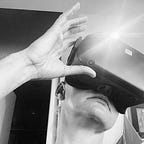How It Started/How It’s Going: Observations from Five Years in VR
Just over five years ago, I flew to Austin to appear on a panel about VR and music at SXSW. At the time, I was still working in the music startup space, but was curious about VR and how it could be used in the music industry. One of my fellow panelists was a VR director named Kevin Cornish, and after the panel we stayed in touch. Within a few months, I had joined his new VR production company, Moth+Flame, doing business development and a bit of everything else, including arranging production insurance, learning how to use InDesign to update a deck in the space of an afternoon, and building Ikea furniture at midnight. After Moth+Flame, I started Friends With Holograms, and in the space of three years went from zero to several Fortune 100 clients, some great awards, and speaking about VR and AR all over the world.
There’s a whole book somewhere in my experience, but given time constraints, I’ll just share the top five things I’ve observed in my five years in the space.
- The headsets are arguably better, but more competition is needed.
When I first started doing demos in VR, my colleague and I wrote a guide to how to set up an HTC Vive, and it was both complicated and cumbersome. Hauling a headset, a gaming PC, controllers, lighthouses, and a million tangled cords all over the city was not a lot of fun, although it was a great workout. Now I can just throw my Oculus Go or Quest in my purse and call it a day. The cost has obviously come down as well — when I started FWH I spent $2500 on a full Rift setup and gaming laptop; my most recent headset purchase was less than $300.
That said, Facebook remains pretty much the only game in town when it comes to affordable headsets, and that’s a problem. Not that the Quest isn’t a great product, but competition always pushes businesses to innovate and would move the industry forward. Google has basically moved away from VR and Apple’s plans are still a black box, and while startups like Pico are promising, there’s no one who can really match Facebook in terms of resources and commitment right now.
2. Creative is still an afterthought
Just like an iPhone without the app ecosystem is just an expensive device for conversations, a headset without good content isn’t worth very much. Content creators still struggle to find sources of funding to make good VR experiences — and if the only path to creating interesting work is self-funding or being connected enough to raise a friends and family round, many important voices will remain shut out.
Large companies that want to create VR are also not investing in creative, and that has consequences. I spoke to someone at a company that had decided VR didn’t work because the piece they built internally flopped. When I asked about the piece, he told me it forced the users to turn their heads rapidly, resulting in motion sickness. When I asked about the experience of the person who built the piece, they had, not surprisingly, never built VR before.
Luckily, things are shifting and more companies are realizing that you can’t just stick an existing training in a headset and call it a day.
3. Shiny object syndrome has finally worn off
Blessedly, the number of VR evangelists who talked a big game but lacked any real experience has diminished greatly in the past few years, as they realized it wasn’t a path to quick riches and went off to yell about NFTs or whatever. Projects have become more thoughtful as people aren’t willing to just throw money at VR and see what happens, and more regular people are buying headsets. The number of people who ask me dumb stuff like “isn’t VR the new 3D TV” has gone to zero.
4. There are still a lot of people who don’t understand the fundamentals
I had a conversation with someone who was in an innovation role at a large company, and she told me that they considered VR for training, but maybe AR would be better, as if the two were interchangeable. They are, of course, very much not.
One major failing of the industry has been the ability to clearly communicate about virtual and augmented reality, and terms like mixed reality or extended reality don’t do anyone any favors. In the next five years, we all need to be very specific about what the technologies are, their use cases, and their limitations.
5. Despite all that, this still fucking rules
Are there boring days and days where this feels like a slog? Totally. But I honestly can’t think of anything else I’d rather be doing. I have met some amazing people and forged some incredible friendships and created work that has changed people’s lives. I am constantly excited about the possibilities of VR and AR and just want to keep building. I constantly see experiences that I love and that push me to think in new ways. Five years from now when I’m sitting atop a giant empire (kidding) (maybe) I know that I’ll look back and have made the right decision.
